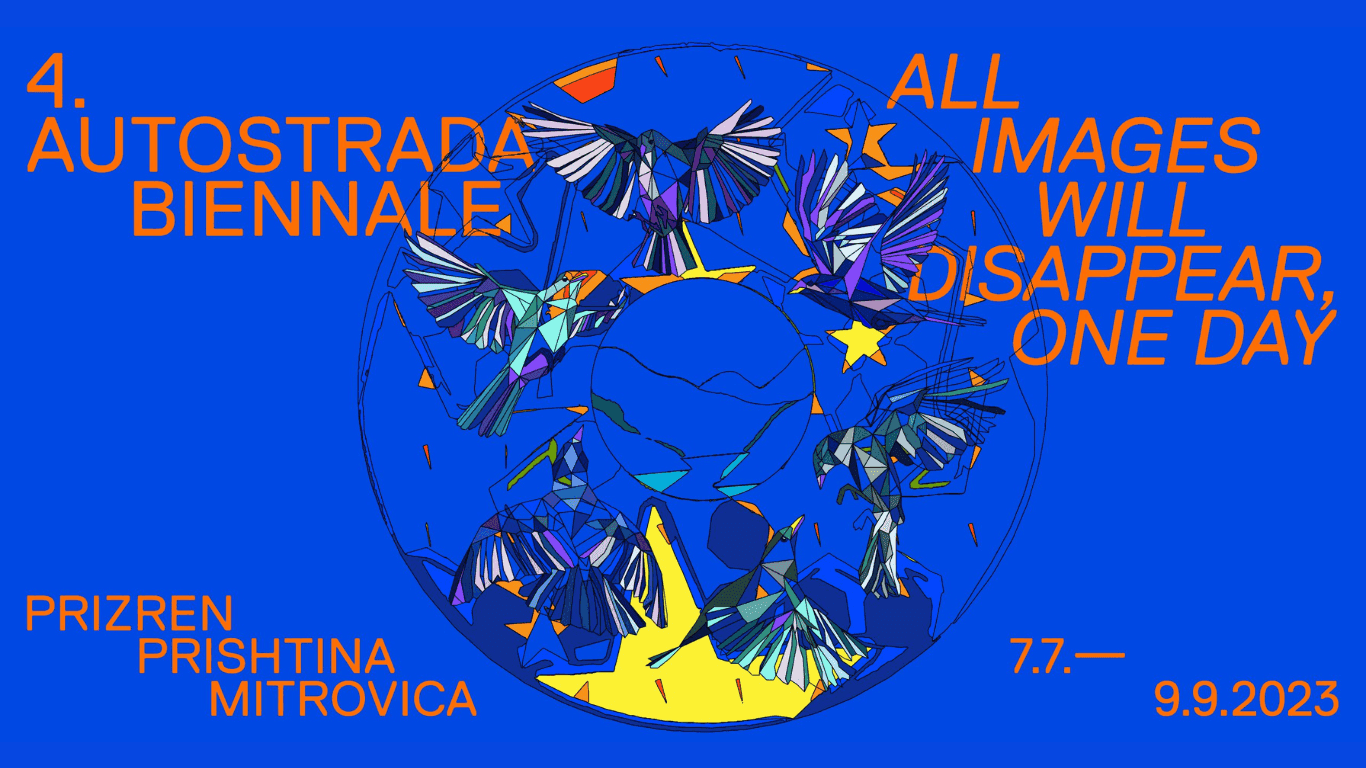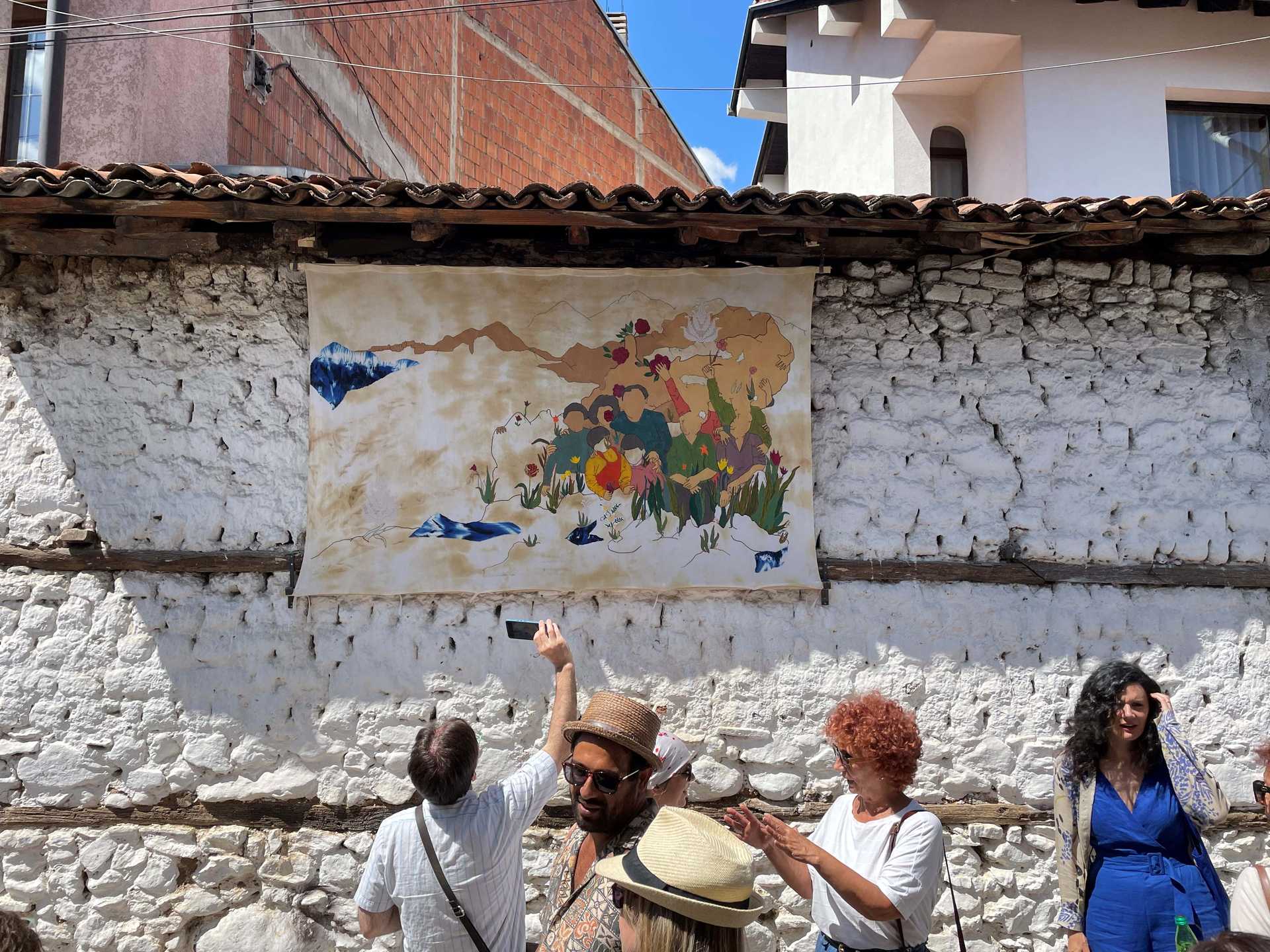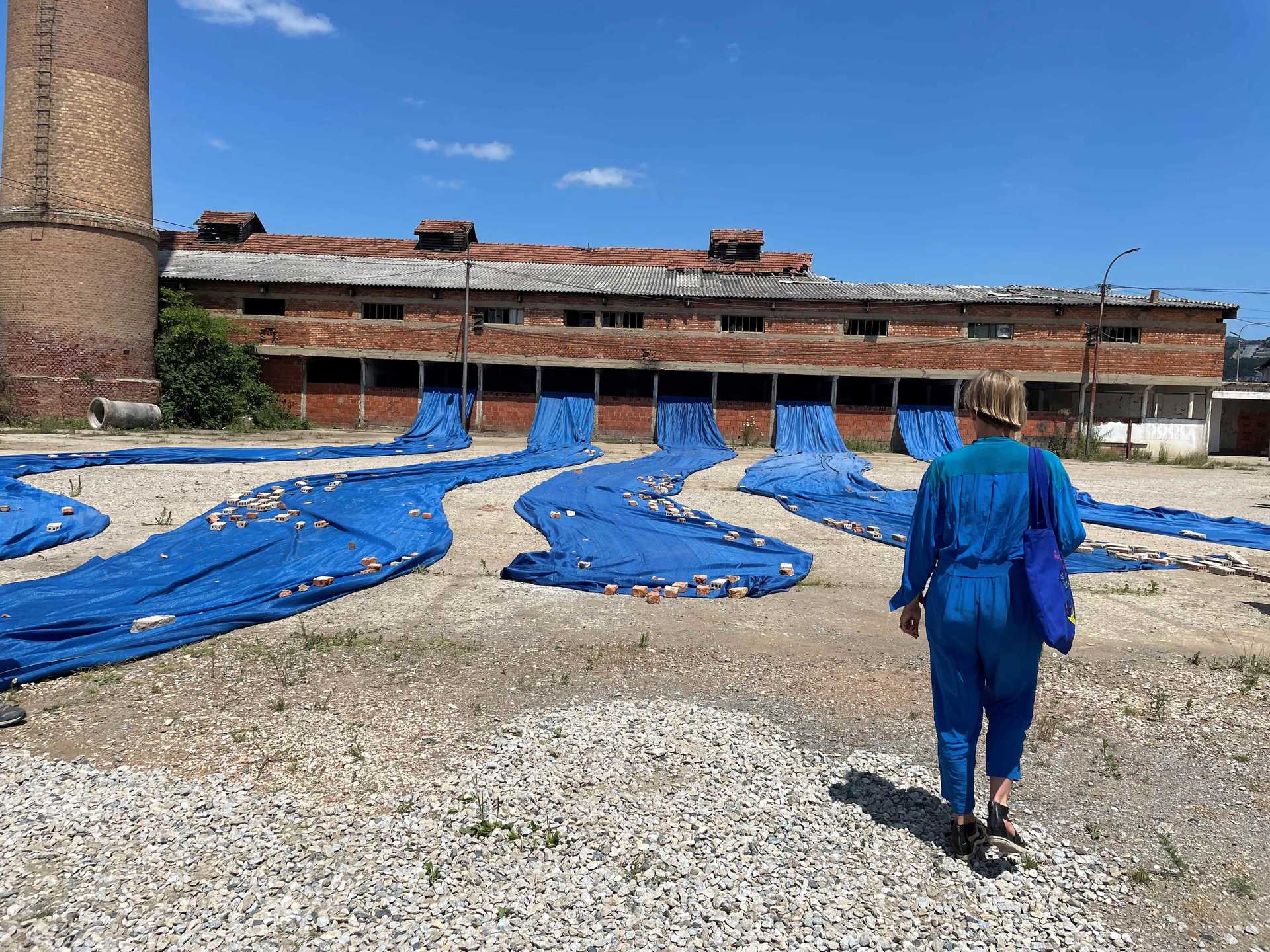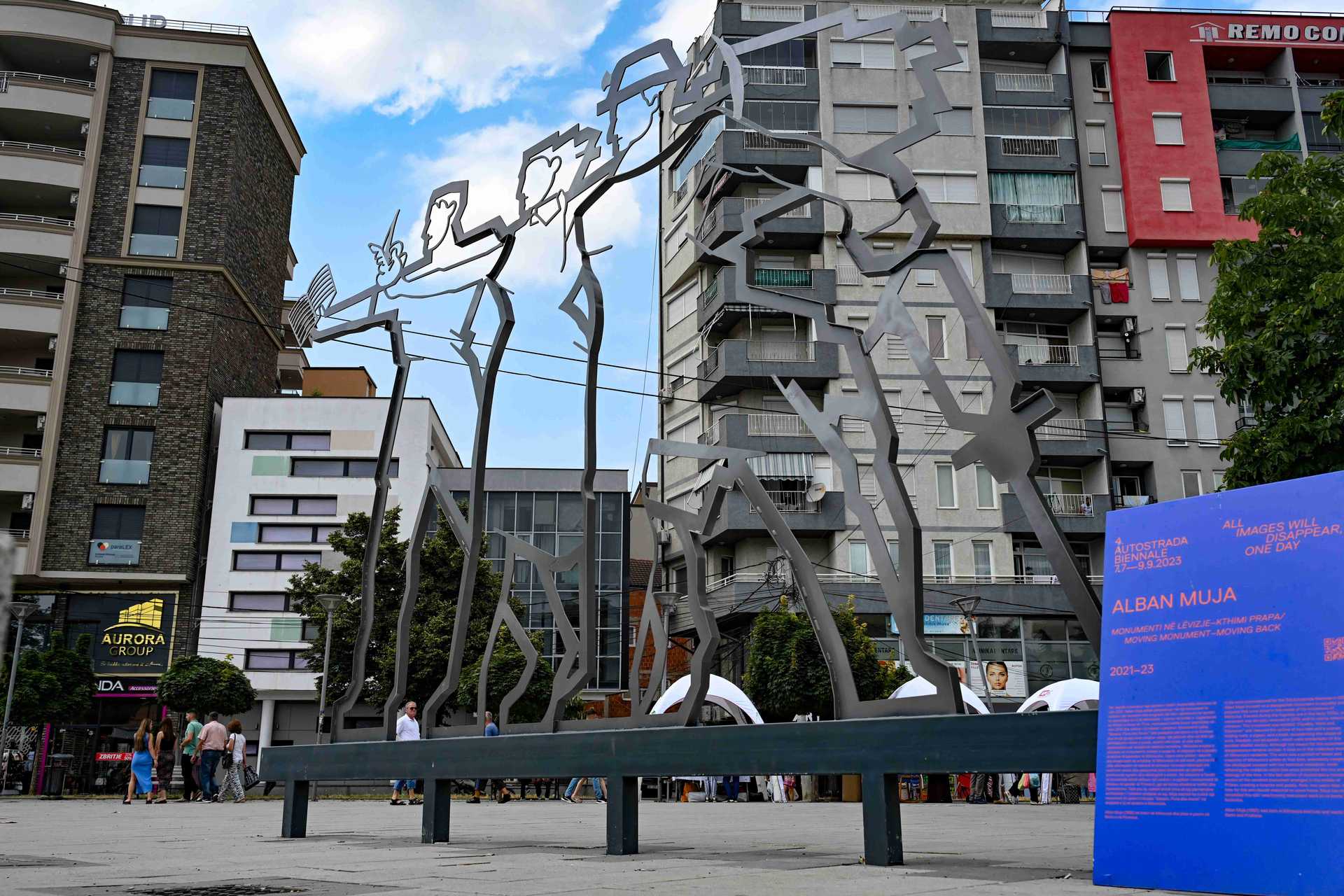“Our main goal is to make art accessible for everyone, for regular people in their everyday habits, their routines of living and working. […] By exhibiting in ‘ordinary’ public spaces that belong to all of us we bring art to the people and not people to the art.”Leutrim Fisheqiu – Co-Director of Autostrada Biennale
Autostrada Biennale 2023: Art touching life
With the fourth edition of the Autostrada Biennale, our Hub partners in Prizren continue their quest to bring art to the people, involve young Kosovar people in the production process, and heal the wounds of a country scarred by war and conflict. A review by our colleague Nino Klingler.
October 27, 2023

Autostrada Biennale 2023 © Autostrada Biennale
Project description
Autostrada Biennale
“All Images Will Disappear One Day”
A review of the Autostrada Biennale by Nino Klingler (Allianz Foundation Program Manager)
Great things sometimes become visible in the very small. One gigantic artwork for the Autostrada Biennale 2023 consists of wide, bright yellow, red and orange lines on a concrete wasteland in the middle of the former headquarters of German NATO troops in Prizren, Kosovo. The Ukrainian artist collective Open Group has traced the ground plans of three cultural sites from Mariupol, on a scale of 1:1, that have been destroyed since the Russian invasion on February 24, 2022. In this way, the ongoing Russian war of aggression in Ukraine inscribes itself on a former military site in Kosovo, where war itself was still raging barely a quarter of a century ago. There is one particularly moving small detail of this work, which at first glance seems rather technical: at one point, the lines, which have been precisely calculated to the millimeter, explode the concrete rectangle the size of a handball field. The grass growing next to it becomes enflamed. One of the buildings destroyed in Mariupol was larger than the available space in Kosovo. The work transcends the stage. Art projects itself into life.

2023 by Open Group © Tuğhan Anıt
This detail is virtually representative of the ethos of the Autostrada Biennale, one of the Allianz Foundation Hubs: it is about art that moves beyond museums and galleries and seeks contact with life, in all its uncertainties. On the one hand, this is about presentation: many parts of the Autostrada Biennale can be seen in public and private spaces, on walls of homes, in apartments, in front of construction sites and in ruins. On the other hand, this is also about how art is made: Many of the works being shown were made on site with a team of motivated young Kosovars in the Autostrada Biennale workshops, which is in a former NATO hangar. This means creating art and practical training in crafting woodwork, metalwork and textiles go hand in hand.
The two curators Övül Ö. Durmuşoğlu and Joanna Warsza have chosen the title “All images will disappear, one day” for the fourth edition. It is about impermanence, about mourning, but also about change and the hope that can arise out of something new. Images, texts, memories: everything is constantly threatening to disappear. - especially when venturing beyond the protected spaces of cultural sites. But even the curators probably would not have imagined how concrete and real their concept would quickly become. Three of the works by Turkish artist Gözde İlkin, who specializes in textile pieces, were installed on the outer walls of private houses in Prizren. İlkin previously had long conversations with the residents in order to develop motifs together, which were steeped in their memories and experiences. Then on the day of the opening, at five in the morning, one of the walls was destroyed by a demolition team – and İlkin's delicate fabric work was buried in the rubble. Instead of art in public space, only a wasteland could be seen, from which an excavator shoveled the remains of the wall. At the same time, it was an image of the often brutal disappearance of Prizren’ old city – and an unexpectedly effective symbol of the curatorial concept of the biennale.

One of the fabric art pieces by Gözde Ilkin in the old town of Prizren (Picture by Nino Klingler).

The leftovers of a house in the old town of Prizren. On the outer walls of this building Gözde Ilkin installed another fabric art piece. Then on the day of the opening one of the walls was destroyed by a demolition team (Picture by Nino Klingler).
The Autostrada Biennale also places a great emphasis on sustainability, on long-term collaboration and organically growing networks. One such example is the gigantic installation by the artist Hera Büyüktaşçıyan, also from Turkey, in a former brick factory in the heart of Prishtina, Kosovo’s capital: the seemingly endless strips of blue fabric flowing like water were repurposed; two years earlier they had been spread out from the citadel high above Prizren down into the valley.

Who Speaks From The Dusk by Hera Büyüktaşçıyan © Tuğhan Anıt
The sunflower fields from Agnes Denes, who is widely regarded as a celebrity of Land Art, are also blooming for the second time – one in Pristina and one next to the Autostrada hangar, amid the former NATO base’s otherwise gray concrete spaces.
However, the work of internationally renowned artist Alban Muja is probably the most impressive example of the Autostrada Bienniale’s unique general approach – working sustainably, on the one hand, while incorporating youth through workshops and sensitively influencing Kosovo’s public life on the other. In his hometown of Mitrovica, Muja installed a 1:1 copy of an anti-fascist monument from the 1970s, when Kosovo was still part of Yugoslavia that had disappeared in the meantime. Two years earlier, a smaller version of this monument, titled “Equality, Work and Education,” had been displayed by Muja in Prizren. Following a long campaign of talk show appearances and political initiatives, the full-size piece was replicated at Autostrada Hangar and installed in downtown Mitrovica – and is to remain there permanently. It is an important symbol in the city, which is now divided into an Albanian and a Serbian area and was shaken by unrest shortly before the opening of the bienniale.

Moving Monument-Moving Back by Alban Muja © Tuğhan Anıt
And the extent to which art inserts itself into life here could be seen at the closing concert, which was high up on the roof of the 7arte cultural center – because Mitrovica is also known for a very young, dynamic rock scene. The band Shrimps chose “Zombie”, the classic hit by the Cranberries, as their last song. Everyone in the audience seemed to know by heart the lyrics that were inspired by the Northern Ireland conflict. And that’s why, in the middle of a divided city, young people yelled words into the night sky that had been written almost thirty years earlier, thousands of kilometers away, in the face of a very different division. But they still resonate today: “When the violence causes silence/We must be mistaken”. In this way, the Autostrada Biennale showed how art can be used to make connections – across generations, communities and borders. We’re looking forward to the fifth edition!

The Band "Shrimps" © Tuğhan Anıt